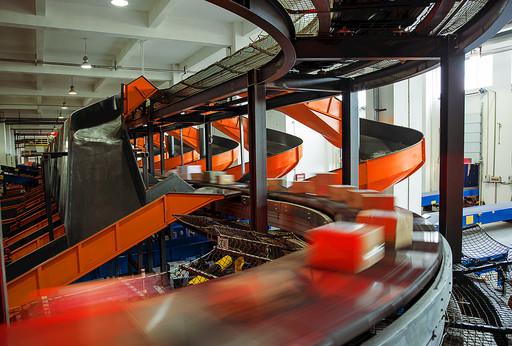Postal Business: 8610 11185
Postal Savings: 8610 95580
Logistics and EMS: 8610 11183
China Post Life: 8610 4008909999
Facing bottleneck of development
In recent years, China’s economy has transitioned from the phase of high-speed growth to a stage of high-quality development under the condition of stable and moderate growth. The consumption growth in general has been slightly declining.
In the first quarter of this year, the total retail sales of consumer goods in China increased by 8.3% year-on-year. Compared with the same period last year, the growth rate dropped by 1.5 percentage points. After deducting the price factor, the actual growth was only 6.9%, decreasing 1.2 percentage points compared with 8.1% in the same period last year. The consumption growth momentum continues to weaken.
Although the e-commerce market has been the biggest driving force in the Chinese consumer market in the past 10 years, its growth rate has also dropped significantly. The annual growth rate of e-commerce transactions has decreased from 59.4% in 2014 to 8.5% in 2018. Consequently, China's express delivery industry has also officially bid farewell to the period of explosive growth, and begun to enter the stage of high-quality development. However, the problem of low efficiency and high cost still exists in the express delivery industry at present, which has become one of the main bottlenecks confronting the whole industry on its way to high-quality development.
At the same time, the consumer-driven era is about to come under the background of industry transformation and upgrading, and meeting the needs of the consumers has become a key factor in the success of enterprises and brands. China's residents' consumption is shifting from quantitative to qualitative improvement. With the constant pursuit of high-quality products and services, Chinese people are attaching more and more importance to the efficiency of express and logistics service. In the current context, cost reduction and efficiency increase have become one of the important ways for express companies to enhance their market competitiveness, and will also become a development trend of the express delivery industry in the long run.
With the market competition getting fiercer and fiercer, China Post needs to tackle the challenges on how to build its postal delivery service into the “national team” of the industry and how to achieve long-term success while embracing changes. The solution must be that China Post should establish customer-centric and market-oriented guidelines. It should make a holistic plan for the whole postal delivery process in order to create synergy across the postal network. Besides, it needs to build a synergic and shared digital supply chain through technology empowerment, and encourage innovative operation models and summarize the achievements and spread the applicable experience after a pilot period.
Forging the national team of the industry
Liu Aili, Chairman of China Post Group, put forward that China Post will focus on building its postal delivery service into the “national team”. To achieve this goal, the guiding principles are to reduce the time limit, cut cost in the whole process, improve service quality, develop target market, and strengthen postal delivery service through IT empowerment. In the effort of putting the guiding principles into practice, China Post should work on the following four aspects.
Establishing customer-centric and market-oriented guidelines. To build the "national team" of the delivery industry, China Post must start from solving customers’ sore points. Based on the customers’ needs, China Post should extend the reach of mail service to the management of the entire supply chain. To be market-oriented, China Post must make breakthroughs in key markets, key regions and key cities. In the market of time-sensitive items, China Post should keep pace and then catch up with its major competitors, commit to cost-effective product lines, and gradually increase its market share. In the market of e-commerce items, China post should continue to consolidate its service coverage, strengthen its cooperation with e-commerce platforms, and focus on products with broad network coverage, so as to gradually reduce losses while maintaining the current market share.
Coordinating all links of the mail delivery process and create synergy across the entire postal network. China Post should make holistic plans for the end-to-end process—from collection, transportation, mail processing to delivery. It should strengthen management and establish a consolidated postal network management system. Major breakthroughs should be made in the networks of core areas. Taking the inter-regional mutual mailing networks as a starting point, China Post must first focus on improving the network efficiency in 52 cities, and gradually coordinate and optimize the resources of the whole network. Apart from that, China Post will establish an agile scheduling mechanism so that the networks can make quick responses and prompt treatment to the services, increasing coordination within regions.
Constructing a synergic and shared digital supply chain through technology empowerment. China Post should make technology empowerment more supportive to business development. It should comprehensively collect the basic customer, financial and operational data, upgrade the internal and external applications, apply intelligent terminal devices widely and construct intelligent decision-making assistance. Postal enterprises should share the data collected from postal outlets, mail transit and trunk routes, and make holistic plans accordingly. Supported by offline physical outlets, postal enterprises should forge a multi-segment collaborative and shared digital supply chain with advanced functions like intelligent scheduling, order management, route tracking, and automatic settlement of accounts.
Encouraging operational model innovation and summary of achievements and spread of their applicable experience after the pilot period. Postal enterprises are encouraged to innovate their business models according to their local delivery development situations. In the future, China Post Group should support its postal branches to innovate the operation models of their postal delivery service through assessment mechanism, then summarize the pilot experience, and promote it according to local conditions.
Transforming from "price war" to "quality war"
In the 2018 annual performance of the major Chinese express companies, their financial data reflects a good momentum of development. In the fierce competition of the delivery market, price control is the key to homogeneous competition. In addition to "price war", reducing cost and increasing efficiency is the general trend, and has become the consensus for development and strategic focus of major express companies in 2019. Under the goal of optimal cost, improving service quality is conducive to building brands and increasing the added value of products, thus providing guarantee for the long-term development of express enterprises.
Express delivery companies have different focuses in their development strategies, but in general, all their strategies include such elements as transformation to integrated service providers, emphasis on service quality and technology empowerment.
1. Interpreting operation via data
By the end of April, express companies have released their annual reports of 2018. In terms of annual operating revenue growth, although the growth rate of e-commerce industry slows down and the express delivery industry officially sees off the explosive growth period, the concentration of express delivery industry is further enhanced and the business growth momentum of leading enterprises is still strong. The year-on-year growth rate of operating revenue of Tongda family—a term used to refer to STO Express, YTO Express, ZTO Express, Shanghai Yunda Express and Best Express because of their similar market positioning and franchise model—was more than 34%, and that of SF Express was 27.6%.
From the perspective of the business income of various express companies in 2018, SF Express, having adopted a differentiated strategic positioning, had an obvious advantage in the middle and high-end market business items, taking the lead with 89.677 billion Yuan (about $13.05 billion). YTO Express ranked first in the Tongda family with 22.903 billion yuan (about $3.33 billion) by constantly optimizing its service franchise network and implementing cost control and other measures. Through a series of effective growth measures such as improving time efficiency, Best Express achieved steady growth in business income, ranking third with 17.703 billion Yuan (about $2.576 billion).
The growth of business income is mainly due to the rapid explosion of the e-commerce items generated by social e-commerce. The growth rate of express delivery volume of Tongda family is over 31%, exceeding the industry average growth rate of 26.6%, showing a good momentum of development. In terms of business volume growth in 2018, ZTO Express led the way with the annual business volume of 8 billion pieces, thanks to its systematic cost reduction and efficiency increase measures, such as optimizing route design, improving vehicle loading rate and transit time, and time definite delivery. Shanghai Yunda Express (hereafter referred to as Yunda Express), driven by favorable factors such as continuously investing in core resources, expanding customer sources, and enhancing customer stickiness, achieved a business volume of 6.985 billion pieces, second only to ZTO Express. YTO Express, with its “lowering price for volume” strategy achieving initial results, had its volume reaching 6.665 billion pieces. Best Express has lost its advantage on low price strategy, so its volume growth slowed down. SF Express was lower in business volume growth rate than the industry average.
From the perspective of gross profit margin, the homogeneous competition brought by e-commerce items has led to the continuous decline in gross profit margin of express companies. In 2018, SF Express positioned itself in business item express delivery. As the price and gross profit margin of business items were much higher than that of e-commerce items, the profitability of SF Express was much higher than that of Tongda family. In the Tongda family, the gross profit margins of ZTO Express and Yunda Express were significantly higher than the other express companies. ZTO Express led its competitors with its large scale, good cost control and profitability. Yunda Express enjoyed a significant reduction in operating costs in 2018, thanks to its continuous investments in large-capacity trailers and automatic and intelligent equipment in recent years. The relatively higher gross profit margins made ZTO Express and Yunda Express competitive in price, which in turn contributed to the increase of their volume as well as their business income.
From the perspective of market share, the leading trend in the express delivery industry has become more prominent. ZTO Express ranked first with 16.8% market share, owing to its better cost control with fine management. Since Yunda Express adopted a lightweight strategy—delivering low value and light weight items, by reducing its weight limit of single package and made a quick increase in its volume, its market share increased rapidly, surpassing other competitors and ranking second with 13.6%. YTO Express continued to accelerate the integration of its business operations, rapidly expanded its global network coverage, built full link cross-border logistics products and services, and comprehensively expanded its strategic cooperation with cross-border e-commerce platforms, thereby enjoying a steady increase in its market share, and ranking third with 13.14%. Due to its overall strategic layout, SF Express fell out of the top five in the express market share.
2. Interpreting competition from price
In terms of the contribution of the main revenue and costs at different segments of the express delivery operation process, the transit segment in sorting centers is the one with the biggest difference between revenue ratio and cost ratio.
The single item income directly affects the revenue of the express companies. In 2018, the unit income of SF Express reached 23.18 yuan/piece on average, which was the highest among express companies. This is because SF Express mainly adopts direct operation business model, and positions itself at the middle and high-end market; and it remains stable in the high-end express market through its high-quality service. Staying away from the low price competition among members of Tongda family, SF Express enjoyed a stable average unit income. Tongda family adopts franchise model, and their income mainly consists of waybill fees, transit fees and delivery fees. Within the Tongda family, the unit income of YTO Express was the highest, 3.44 Yuan / piece; followed by STO Express, 3.24 Yuan / piece; Yunda had the lowest unit income in the family, with 1.74 Yuan per piece. In terms of the single-item gross profit margin, SF Express was the highest, at 4.33 yuan/piece; ZTO Express was the highest in the Tongda family, 0.73 yuan/piece; STO Express was the next, 0.61 Yuan/piece; Best Express the lowest, 0.12 Yuan/piece.
In recent years, the single-item gross profit margins of express companies were stable with a slight decline, and the decline is shrinking. The fact that express companies had control over the decline of their unit income means that the competition in the express delivery market has shifted from “price war” to “quality war”.
Among the factors reflecting price, cost is the core competitiveness of express companies, while the costs of express waybills, transportation, transshipment and delivery mainly determine the overall cost. The reduction of single item cost can cause the rise of the profit margin, and lower single-item cost means larger room for price-cut and stronger profitability. At present, the single-item cost of express enterprises shows a steady downward trend. In 2018, in Tongda family, ZTO Express had the lowest single-item cost, 1.09 yuan/piece. Best Express had the highest, 3.2 yuan/piece, as it continued to suffer losses in spite of its rapid increase in business volume. The single-item cost of YTO Express was 3.18 yuan per piece, the reason is that even though YTO Express enjoyed a cost reduction under the scale effect, the marginal utility decreased as its scale reached a certain level, and the cost was still the “bottleneck” to price cut.
● Waybill costs
With the prevailing of electronic waybills, the waybill costs have been further reduced, and their impact on operating costs has become smaller and smaller.
● Transportation costs
Transportation costs mainly include fuel consumption, drivers’ salaries, toll charges, etc. From the perspective of single-item transportation cost, as ZTO Express has increased its vehicle loading rate and transit time efficiency due to its large-scale use of large-capacity trailers, its transportation cost has been lower than the industry average. In 2018, the single-item transportation cost of Yunda Express decreased by more than 10%. On the one hand, it has benefited from its large volume. On the other hand, it also benefited from its transportation cost optimization strategies, including merging transit centers, actively optimizing transportation lines, adopting trailer transport, optimizing routes, and encouraging self-run trunk line transportation, all of which have greatly improved its transport efficiency and achieved remarkable effects on cost reduction. STO Express drove its single-item transportation cost down by its continuous route optimization and the increase in self-owned vehicles.
● Transit costs
Transit costs mainly include labor costs, site rents or depreciation and amortization. Among them, labor costs account for a large proportion, and the number of workers is positively correlated with business volume. YTO had the highest proportion of air transportation, so its transit operation costs were higher, and its single-item costs were higher than those of other express companies of Tongda family. Yunda Express enjoyed the lowest single-item transit costs, because it has adopted innovative “cost-leading” competition strategies, and taken advantage of its earlier transit automation than its peers, thus driving costs down. With the introduction of automated sorting equipment into transit centers, ZTO, Yunda and STO are all able to reduce their labor costs by 70% to 80%.
3. Interpreting development from cost reduction and efficiency increase
Express enterprises have entered the era of fine management. Cost reduction and efficiency increase are important ways for them to upgrade their service quality.
● Direct operation of transit centers
High direct operation rate is one of the competitive advantages of express enterprises. Promoting direct operation rate of transit centers has become the law of development of express delivery industry. The mode of "direct operation of transit centers" has been proved to be effective in reducing the cost of the whole network. The higher the direct operation rate of transit centers is, the stronger management and control the headquarters have over its transit centers and whole network. Higher direct operation rate of transit centers will also help improve the efficiency and stability of the whole network.
According to the 2018 annual reports of express enterprises, Yunda Express has 20423 distribution outlets and 54 transit centers nationwide, all of which are self-run, thereby strengthening its hub management and control. ZTO Express has 30,100 outlets, and has the largest self-owned land area and scale of transit centers among the express enterprises of franchise model; its direct operation rate of transit centers reaches 91.57%, effectively improving its processing capacity. Best Express has 64 transit centers, 100% self-run, with automation level constantly improving. STO Express has accelerated its direct operation in recent years, the increased cost has led to the increase of single-item transit cost, but the increased rate of the cost is lower than that induced by the increase of direct operation of transit centers, indicating that the fine management of STO Express has a remarkable effect. SF Express has 375 directly operated transit centers. YTO Express has 37700 outlets, and continues to strengthen its direction operation of transit centers.
● Self-operation of trunk line transportation
Accelerating the purchase of self-owned vehicles will help reduce transportation costs quickly and increase marginal profits. Self-operation of trunk line transportation is the premise of cost control. Yunda Express, ZTO Express and YTO Express all had their transportation costs cut in different ranges, and the main reason lies in the increased proportion of self-run trunk line vehicles. Yunda Express reduced its trunk line transportation routes from 4500 to 4300 in 2018. At the same time, it purchased more vehicles to increase its own transport capacity, facilitating cost reduction effectively. YTO Express had fewer self-owned trunk line vehicles and relied heavily on third-party logistics, so its transportation costs were higher. At present, YTO Express has increased its self-owned vehicles to 1244, which will help bring down its transportation costs. ZTO Express has 4500 trunk line transport vehicles, the highest proportion of self-owned vehicles among the three express companies. Therefore, it has stronger management and control over its trunk line transportation, and can organize and coordinate its trunk line transportation more effectively, thereby having higher operational efficiency.
● System automation
In the future, the development of the industry will be shifted to intelligent logistics. Therefore, information and intelligence are very important for express enterprises. The investment in science and technology and the penetration of automated equipment can help reduce costs and improve efficiency. In 2018, ZTO Express brought 120 automatic sorting systems into operation in the whole network, the automation rate of transit centers reaching 82%, achieving a leading edge in the penetration rate of automated equipment. Yunda Express had the best logistics information technology system in the Tongda family, and its automated equipment and information technology led the industry. YTO express transformed its sorting model from "manual + machine" to automation, and greatly reduced the demand for and dependence on manual sorting staff in transit centers. STO Express has highly automated distribution centers, and its investment in automatic sorting equipment can partly offset its labor cost, therefore reducing the single-item distribution costs.
4. Interpreting transformation from service quality
Cost reduction and efficiency increase bring about the improvement of service quality, and will further promote the development of express industry. Highly homogeneous express enterprises need to achieve transformation with improved service quality. The service quality of express enterprises is determined by timeliness and safety, and the complaint rate reflects the comprehensive service quality of express enterprises. In 2018, the valid complaint rate in Tongda family showed a significant downward trend; SF Express had the lowest valid complaint rate, followed by Yunda Express. The improvement of service quality is helpful for express enterprises to enter a healthy cycle in which good service promotes development, development then drives innovation, and innovation in turn nurtures service.
 |






